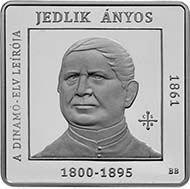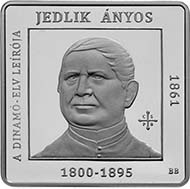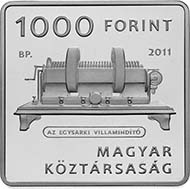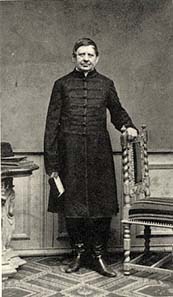January 21, 2011 – January 11, 2011 the Hungarian mint has issued a new commemorative coin dedicated to Anyos Jedlik and the principle of the self-excitation in 1861.
Anyos Jedlik and the principle of the self-excitation in 1861 – 1.000 HUF – CuNi – 14 g – 28,43 x 28,43 mm – 10.000 BU & 10.000 Proof – designer: BITO Balazs – date of issue: January 11, 2011.
Ányos István Jedlik OSB (Szímö, 11 January 1800 – Györ, 13 December 1895)
Amongst other things, his name is associated with the construction of the first electric motor, and discovery of the principle of dynamo self-excitation and voltage amplification.
Jedlik was taught as a Benedictine monk from 1817 and was ordained as a priest in 1825. He began teaching at the Lyceum in Györ, and was a teacher at the Academy of Pozsony (present-day Bratislava) from 1831 to 1839. From 1840 to 1878 he taught physics and mechanics at the Budapest University of Sciences, as head of department, where he also held the offices of dean and rector. He began instructing at the university in Hungarian in 1845, and at the request of Ferenc Kazinczy and Gergely Czuczor (Jedlik’s cousin) he started developing Hungarian technical and natural science vocabulary (creating, for example, the Hungarian terms for ‘vertical’ and ‘piston’).
Anyos Jedlik. Source: Wikipedia.
He joined the national guard in 1848. After the revolution was crushed, he continued teaching, but only in German. It was during these years that he worked on his inventions and textbooks. He was a member of the Hungarian Academy of Sciences from 1858. He retired to the priory in Györ, where he continued his work in possession of all his faculties until his death.
As a young man, Jedlik was interested in a broad range of subjects, experimenting with chemistry, electrochemistry (elements) and later turning to electricity. He also did excellent work in experimental wave theory and optics as well. During his tenure at Györ he built the first electric motor. In 1826, he designed the “apparatus acidularis” device for the production of artificial carbonated water. The device was used to begin the first commercial production of soda water.
The Jedlik dynamo. Source: Wikipedia.
Jedlik’s name is incorrectly associated with the discovery of the dynamo in popular culture. He actually did not discover the dynamo as an electric device, but rather recognised the principle of self-excitation, and was the first in the world to describe this in writing in 1861. Definitive proof of this comes from the archives of the Hungarian Royal University of Sciences, which states the date upon which the unipolar inductor was built by Jedlik. The documents also discuss uses of the device and the discovery of the self-excitation principle is set forth under Point 4. Thus, there is documented evidence that Jedlik discovered the principle behind the operation of the dynamo at least six years before Werner Siemens and Sir Charles Wheatstone. He did not patent his invention, and hence unfortunately the chronicles of science and the international public do not afford Jedlik the recognition he deserves in this regard.
Commemorating the 150th anniversary of the description of the dynamo principle, the Magyar Nemzeti Bank is issuing a commemorative coin in honour of Jedlik, the seventh coin in the series celebrating Hungarian engineers and inventors, and their innovations and inventions.








